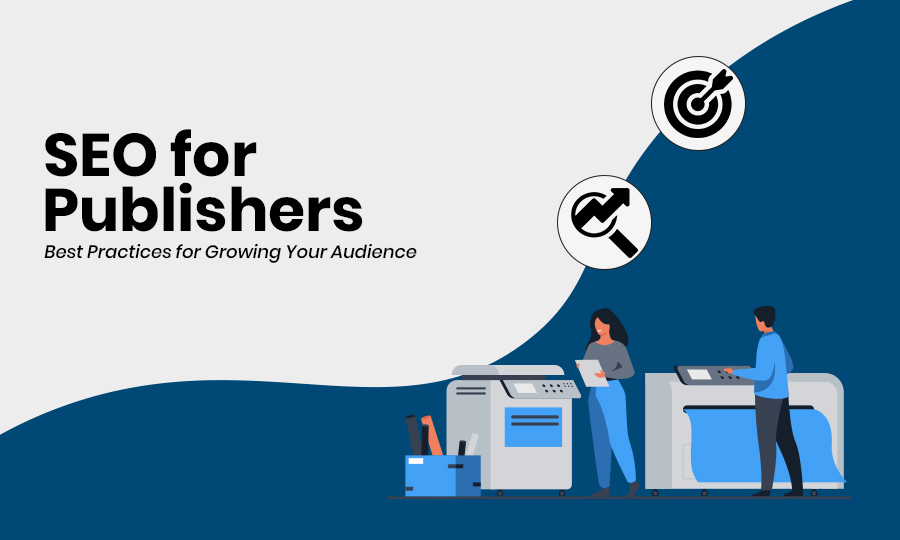The worldwide publishing industry is growing with USD 18.9 million from 2025 to 2029, and some projections expect a CAGR of approximately 1.2% to 3% for the wider book market, while the digital publishing segment is rising faster, with one forecast predicting a 9.67% CAGR until 2032. So, how can your publishing house be the one that catches the eyes of the competition? That’s where SEO for publishers becomes your exclusive opportunity to figure out and gain your share of this huge industry.
In “The Effectiveness of Search Engine Optimization (SEO) In Marketing: A Meta‑Analysis Study” (2024), the authors found an effect size (d) of 1.049 (in the “high effect size” category) for SEO implementation, which can improve organic search rankings and website traffic. So, being a publishing company owner, you need to maintain online visibility with a proper publishing website with SEO optimization to attract more traffic.
So, in this comprehensive guide, you’ll discover the verified publisher SEO strategies that successful publishers use to dominate search results. We’ll walk you through everything from mastering relevant keyword research and optimizing for Google News to applying internal linking and handling duplicate content with canonical tags. You’ll learn how to optimize images for faster load times, create evergreen content that draws sustained traffic, and build off-page authority that Google rewards.
If you’re starting a new publication or growing an existing one, this guide offers doable strategies to improve the visibility of your content, expand your readership, and turn search engines into your most valuable source of traffic. So let’s take a deep dive into the best SEO practices for publishers.
What is SEO for Publishers & Why is it Important?
SEO for publishers is the online marketing strategy that helps your publisher’s site to appear at the top of the search engine results page (SERP). Almost 95% of people do not scroll to the second page. So, search engine optimization (SEO) will help your website acquire the best search engine rankings. But you need to implement the right SEO strategy to improve your website’s position on the SERP.
The Significance of Publisher SEO Strategy
- Search Visibility Is More Important Than Ever- The digital world has changed how people find content. Your content will either reach thousands of people or stay buried on page ten of search results if you don’t take care of search engine optimization. Publishing companies endure intense competition in an overflowing market. Every article you publish competes with millions of others for attention. So, without proper optimization, even your best work stays invisible to potential readers. The path to increasing online visibility starts with understanding how search engine crawlers examine and rank your content.
- Real Results from Strategic SEO Implementation- 91% of marketers said that SEO made their website work better in 2024. Publishers who use full SEO strategies usually see 150 to 300 percent more organic traffic after a year.
- Strategic Implementation Drives Growth- Search engine optimization (SEO) is more than just building links and using redundant keywords. Today’s search engine optimization needs to focus on technical excellence, content authority, and want to improve the user experience. Your success will depend on how well your search engine visibility matches what readers want and what search engines need. It’s important to stay up-to-date with the latest trends and algorithms to stay ahead of the competition.
Why Should Publishers Focus on Google News Optimization?
In the competitive world of digital news, publishers should put a lot of effort into Google News Optimization (GNO), which is a key strategy to increase visibility, attract high-quality traffic, and establish authority.
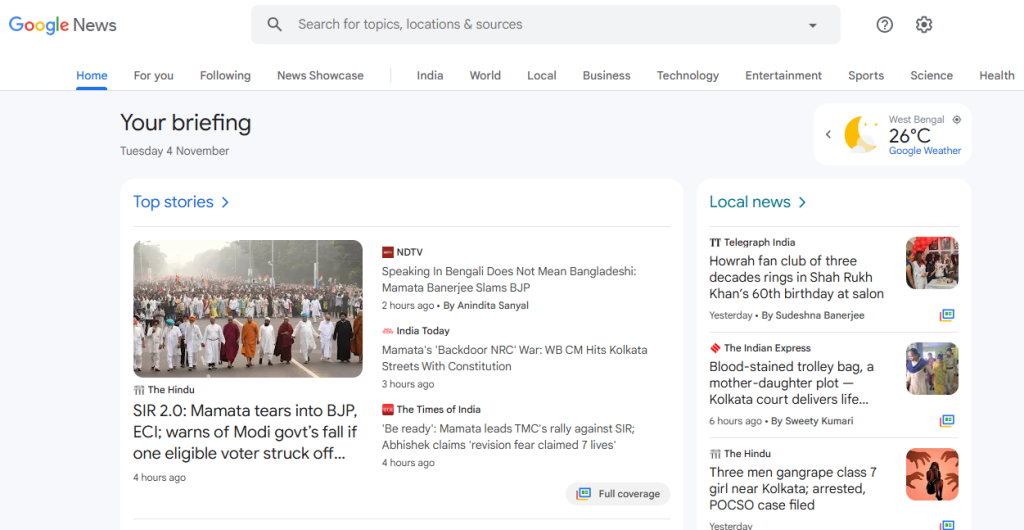
Google News collects a huge amount of news and gives publishers a lot of exposure on many Google pages, such as the Google News app itself, the “News” tab in Search, the popular Top Stories carousel, and the personalized Google Discover feed. This grows in popularity and directly generates leads to a lot of referral traffic, which often makes up a big part of a news site’s total readership. This increases the site’s ad revenue and subscription potential.
What Is The Must-Follow Rules for Google News Inclusion?
Google now uses algorithms for automatic inclusion (meaning you don’t “apply” anymore); your content must thoroughly meet the overarching Google News Policies and Google Search’s general guidelines. You may be moved down or even removed from all news surfaces, including Top Stories and Google Discover, if you don’t follow these rules.
- Unique and Original Content: You need to publish only original reporting, analysis, or commentary, so you should stay away from duplicate or scraped content.
- Clear Authorship: Then you can display author names, bios, and publication dates for transparency and trust.
- Accurate and Honest Reporting: Follow journalistic standards with verified sources and fact-based writing.
- Readable Page Structure: Use a single, clear headline (H1), short paragraphs, and a logical article layout.
- Permanent URLs: Each article should have a separate, accessible, and permanent URL.
- No Paywall Barriers Without Proper Markup: If content is behind a paywall, use structured data (NewsArticle with isAccessibleForFree markup).
- Structured Data Implementation: Add the NewsArticle schema for the headline, image, author, and datePublished fields.
- Fast Loading and Mobile Optimization: You need to make sure that your website loads quickly and maintains speed and a responsive design for a better user experience.
- Avoid Clickbait and Misleading Titles: Keep headlines descriptive and accurate to maintain credibility.
- Verification in Google Publisher Center: Verify your publication to manage visibility, branding, and eligibility.
- Proper News XML Sitemap: Submit a dedicated news sitemap with fresh URLs published within the last 48 hours.
- Freshness and Timeliness: Regularly publish up-to-date news content to stay relevant in Google News feeds.
- Ad Placement Control: Avoid intrusive or excessive ads that disrupt the reading experience.
- HTTPS and Security: Use HTTPS for safe browsing and to maintain trust signals.
- No Malicious or Spam Behavior: Follow Google News content policies—avoid auto-generated or deceptive content.
How To Do Keyword Research to Improve Your Content Strategy?
If you want your publishing company’s website to be at the top of search results, you need to find relevant keywords. So you need to understand first what keywords are. And how keyword rankings in search engine optimization.
The specific search terms a user puts into Google to search for any products or services are called keywords. And you have to find out those terms. As a publisher, your main goal is to get organic traffic from readers and make your articles more visible in search results.
So, you should use a mix of industry, topic, and audience-intent keywords that are relevant to your publication.
- Know Your Target Audience
You need to know what your target audience wants. Then you have to plan your keywords accordingly. A tech audience searches differently from a lifestyle reader.
How to do it:
- You can use Google Analytics and Search Console to see what topics attract the most traffic.
- Study audience demographics, interests, and engagement time.
- Moreover, you can analyze reader comments and social media feedback for new content ideas.
- Take Ideas from Reliable Keyword Tools
Most modern keyword research tools can help you find phrases that people in your target audience are actually looking for.
Try:
- Google Keyword Planner—for monthly search volumes and related terms.
- Google Trends—to track topic popularity and seasonality.
- Ahrefs / Semrush / Ubersuggest—for difficulty scores, SERP insights, and competitor keywords.
- AnswerThePublic—to discover questions people ask about a topic.
- You Can Use Topical Keywords (Based on Your Niche)
If your publication covers specific topics, use relevant search phrases readers actually use. For example:
If you cover Tech:
- AI tools for everyday users
- Future of technology in education
- Smartphone innovation trends
If you cover Lifestyle:
- Best wellness routines for busy people
- Healthy diet tips for 2025
- Minimalist home decor ideas
Audience-Intent Keywords
These attract the type of readers your publication wants:
- Latest updates on [topic or region]
- Expert opinion on [specific issue]
- In-depth analysis of [industry event]
Use Evergreen + Trending Mix
- Evergreen: “What is digital journalism?”, “How to fact-check news”
- Trending: “AI-generated news tools”, “Election 2025 media coverage”
- Analyze Search Results for Content Gaps
Furthermore, the search results page helps you understand what Google values.
How to do it:
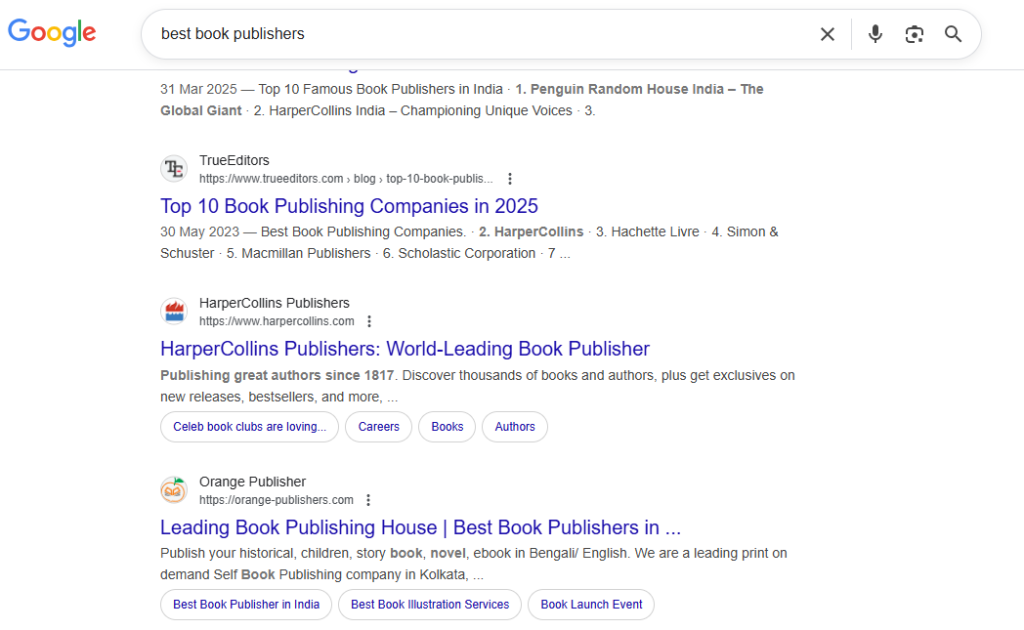
- Search your keyword and note what kind of pages rank — breaking news, explainers, or listicles. You can see which sources use those same keywords. It will help you to optimize content visibility more professionally.
- Check “People Also Ask” and “Related Searches” for secondary keyword ideas.
- Observe headline styles and content depth among top-ranking competitors.
- Practical Guide to Keyword Research for Publishers with SEMrush Tool
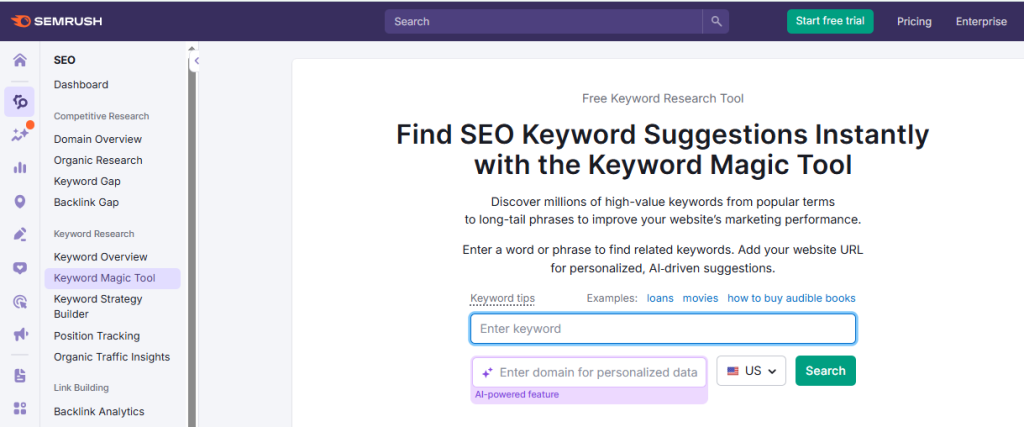
You need to go to “Keyword Magic Tool” and put your main keyword. Most of the local searches can be started with “best publisher in(put area name)”. If you put these keywords in your content, then your user can find you easily, when they serach for these kinds of keywords.

Focus On Target Keywords with Intent
Not every high-volume keyword benefits publishers. The best approach is to find target keywords that fit user intent—informational, news-based, or evergreen.
How to do it:
- Identify topics that match your editorial niche.
- Prioritize keywords that answer “what,” “why,” or “how” questions.
- Include long-tail variations for better reach (e.g., “AI in education policy 2025”).
Search Intent- Search intent means the reason behind a user’s Google search — what they want to find or do.

Types:
- Informational: Your Readers want to learn or understand something. (e.g., “How much does it cost to print a book?”)
- Navigational: They want to reach a specific brand or platform. (e.g., “Book editing services by [your site name]”)
- Transactional: The user wants to buy or subscribe. (e.g., “Hire a professional book editor”)
- Commercial: Readers are exploring options before deciding. (e.g., “Best book publishing companies for new authors”)
Choosing Tip:
- You should pick keywords that match your content type.
- But don’t do keyword stuffing throughout content; it can be monotonous for readers.
- When you create articles or landing pages, use informational and commercial intent keywords for blogs or guides, and transactional intent keywords on service or submission pages.
How Can Publishers Make Evergreen Content That Drives Long-Term Traffic?
When it comes to content publishers, evergreen optimizing content is the key to long-term growth. Breaking news generates immediate interaction, but evergreen subjects offer constant exposure and constant organic traffic. This balance helps online publications rank higher and retain readers.
- Balancing Breaking News with Evergreen Articles
Being a publisher, you must balance time-sensitive stories with timeless pieces. Breaking news attracts immediate attention but quickly fades away. Moreover, evergreen content—such as how-to guides, author interviews, or historical insights—keeps readers coming back. A strong mix helps publishers create a sustainable audience base that doesn’t depend solely on daily news cycles. For page content, 70% news and 30% evergreen is a healthy ratio for steady engagement.
- Topics That Remain Relevant Over Time
Most of the articles focus on relevant content that never loses reader interest. Such as-
- “How to Publish a Book Step by Step”
- “Understanding Book Royalties and Contracts”
- “Best Practices for Manuscript Editing”
These remain valuable months or even years later. Online publications should choose topics that answer consistent reader questions or solve long-standing problems in the publishing or writing industries.
- Update New Content Strategy
Content publishers must constantly review and modify older articles to retain content freshness. You can do minor adjustments, such as updating graphics, adding new data, or editing examples, to support the maintenance of high-quality content. This also shows Google that your website prioritizes relevance and accuracy, which can raise its ranking in search results.
- Traffic Sustainable Gains
The biggest advantage of optimizing content lies in traffic sustainability. Through internal linking and search engine optimization, consistent posts generate frequent organic visits, even as breaking news causes spikes. This frequent flow of visitors increases ad exposure and reader loyalty. As the site’s authority grows over time, posts also improve the performance of other page content in search results.
- Content Refresh Schedules
You need to establish content refresh schedules to keep your content up-to-date and applicable.
- Review your content every 6–12 months for scientific accuracy..
- Rewrite outdated introductions or references.
- Moreover, you can insert new internal links to fresh stories.
- Try to improve images and meta descriptions for higher prominence.
How Does Off-Page SEO Build Your Publication’s Authority?
Search engines consider your publication to be a reliable source that is worth ranking based on off-page SEO. Backlinks remain the #1 ranking signal in the Google search algorithm. In this segment, you will discover off-page SEO for publishers techniques and how to effectively build backlinks to improve your search engine ranking.
- Digital PR Strategies That Promote Authority
- Many publishers overlook digital PR as a key off-page strategy. Digital public relations uses contemporary techniques to increase your brand’s visibility and credibility online through content partnerships, media outreach, and strategic networking. The approach transforms your publication from an isolated voice into an industry authority that journalists reference.
- Research where your target readers spend time. Moreover, you can use tools like SparkToro as a starting point to identify relevant platforms backed by search data and organized by audience types, interests, and other variables. You need to develop a media list that includes both well-known publications and niche websites that will help you become an expert in your field.
- You can craft pitches journalists actually want. You can research topics that are popular at the moment to get journalists interested in your work and encourage them to publish it in well-known magazines. Your pitch should highlight what makes your story newsworthy, not why your publication deserves attention. Moreover, you need to focus on unique angles, timely data, or expert perspectives that fill gaps in current coverage.
- Guest Posts and Contribution Strategies
Guest posts can help you build high-quality backlinks that improve your rankings and get your brand in front of a whole new group of people. They can also lead to brand mentions that aren’t linked to your site. If you want to get published, you should go after websites that are known to be trustworthy in your field.
- Follow this systematic approach:
- Identify high-authority sites in your niche using domain authority checkers. Look for publications that maintain active audiences and publish quality content regularly.
- Study their existing content to understand what topics resonate with their readers. Avoid pitching ideas they’ve already covered unless you bring genuinely fresh insights.
- Pitch topics that align with both publications. Don’t just ask for a backlink—offer unique, well-researched content that fits their audience. Your article should provide value to their readers first and serve your SEO goals second.
- Include your byline strategically. Link to relevant articles on your site that expand on points mentioned in the guest post. Use descriptive anchor text that tells readers exactly what they’ll discover.
- Connections with Other Publishers
- People are very important in the publishing business. It’s easier to get backlinks over time if you have good relationships with publishers. This can lead to more print opportunities. These relationships create ongoing opportunities rather than one-off transactions.
- You can work together on research initiatives that will benefit both publications. Collaborate on industry publications, run pooled polls, or assemble expert roundups, with each publisher contributing unique views. These partnerships naturally produce reciprocal connections, expanding both audiences.
- Then you can participate in industry communities where publishers gather. Moreover, you can respond strongly to debates, contribute ideas from your articles, and provide assistance without expecting quick results. Then you can post in niche-specific forums like LinkedIn and Quora, which may help you gain authority, generate traffic, contribute great ideas, get helpful comments, and create connections with colleagues and possible partners.
- Social Engagement and Visibility Signals
- Social media doesn’t directly impact rankings, but it increases everything else. Supporters, followers, and mentions on social networks don’t directly affect a search engine’s ranking, but they do help content get more backlinks and better participation indicators.
- Thereafter, you can share your content in a smart way on platforms where your audience hangs out. This can ultimately lead to an increase in organic traffic to your website.
- You can follow social conversations about your publication and industry. Use social listening tools to track brand mentions and discussions in your niche, and when someone mentions your brand, connect with them. These contacts create interactions, which often contribute to natural link possibilities and higher rankings.
- Brand Mentions and Unlinked Citations
- Not all worthwhile mentions have a hyperlink. Although they are not as powerful as backlinks, unlinked mentions still contribute to the development of brand signals that Google analyzes to determine if your website is a legitimate brand. These references add to your overall profile of authority.
- Moreover, you can find brand mentions that aren’t connected to your website by using Google Alerts or brand monitoring tools. Then, get in touch with the publications and ask them to include a connection to your website. This basic promotion turns already-existing remarks into useful backlinks.
- Backlink Profile Management to Improve Publisher SEO Success
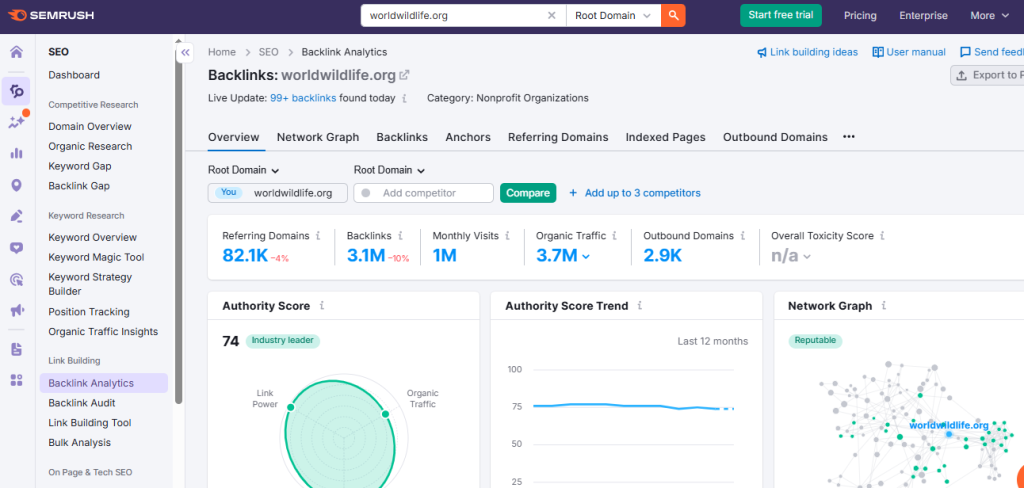
Search engines can learn about your publication’s image from its linking profile. High-quality backlinks come from sites that are authoritative and important to your field. These are the links that make your site more reliable and raise its domain authority.
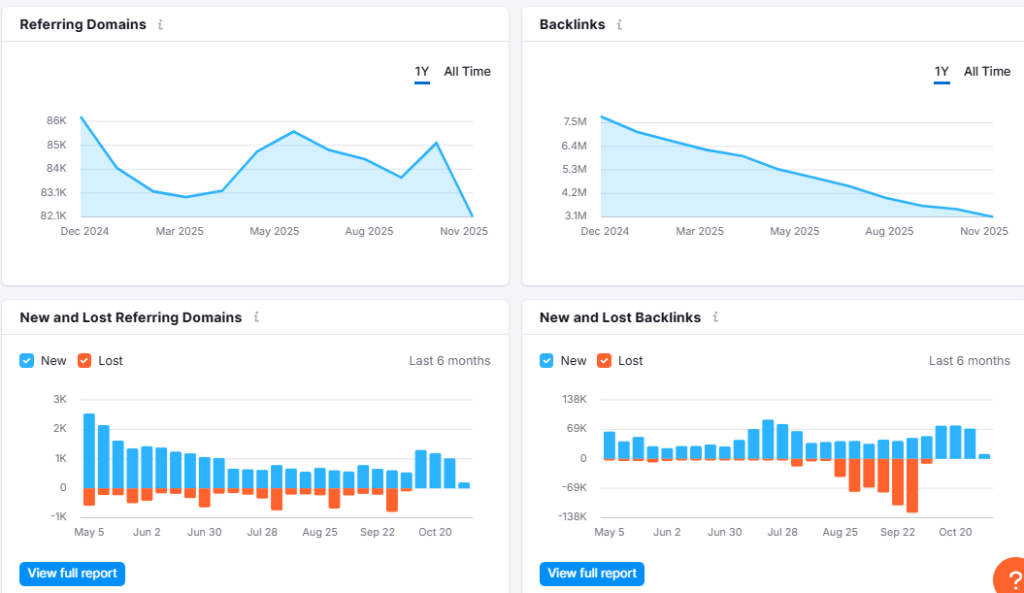
Audit your current backlinks quarterly—you can benefit from tools like Ahrefs or Semrush to identify which links provide benefit and which might harm your profile. You can use these tools to examine the backlink profiles of your competitors, find the ones that perform the best, and then target those same sources with superior content or distinctive value propositions.

Focus on relevance over volume – quality, not quantity, is more important when it comes to building links. Therefore, you can aim for backlinks from reputable, credible sites in your industry, as these will send a stronger, more positive signal to search engines. A link from a well-known trade magazine is worth more than dozens of links from low-quality sites.
Which On-Page SEO for Publishers Strategy Do You Need To Follow?
On-page seo refers to the changes that you make inside your website. Here you can get to know how you can maintain your on-page seo for publisher strategy to rank higher in search engine results.
Meta Tags & Meta Descriptions Improve Your Click-Through Rate

An effective meta description & tags explain the value of your article to both readers and search engine algorithms.
How to do it:
- You can create a summary within 150–160 characters.
- The ideal meta tag should be within 55-60 characters.
- Add your important content keyword naturally.
- You can help your reader to easily understand why they should click—use language that is based on actions. This will improve your click-through rate and ultimately drive more organic traffic to your website.
- The meta descriptions should be unique for each article to help other search engines detect significance.
Title Tags With Target Keyword
Title tags inform search engines how to show your article.
How to do it:
- The ideal title tag should be under 60 characters.
- And most importantly, you need to place your target keyword right at the start.
- Make it informative but relatable for all readers..
- Avoid repeating the same keyword in multiple titles.
Header Tags (H1, H2, H3)
Header tags support the structure of your article and show search engines and readers what to do.
How to do it:
- Use one H1 tag for the main topic.
- Split sections with H2 tags for higher readability.
- Use H3 tags under H2 for supporting ideas or examples.
- Add important content keywords in headers naturally.
URL Structure (Clean, Readable, Keyword-Rich)
A URL (Uniform Resource Locator) is the web address that shows the exact location of a page on the Internet. It helps browsers find and open a specific website or article quickly, like an online home address for content.URLs tell you what the page is about.
How to do it:
- Keep URLs short and simple.
- Use hyphens (-) instead of underscores (_).
- Add your main keyword, but avoid keyword stuffing.
- Do not use numbers or special characters.
What Technical SEO Elements Are Important for Publishers?
Technical SEO success is very important for publishers. Your website should be maintained with the following strategies. It will bring more traffic if you maintain all these technical seo for the publisher techniques.
Site Architecture for Publishers
The optimal publisher URL structure is domain.com/category/subcategory/article-title, which provides a clear hierarchy and distributes page authority. Your structure affects how search engines understand content relationships.
Steps to organize your site:
- Create main category pages for broad topics (Politics, Business, Technology)
- Add subcategory pages for specific niches under each main category
- Link articles to their parent category and subcategory pages
- Build a logical navigation menu that shows this hierarchy
- Limit clicks from the homepage to any article to three or fewer
Maintain Page Speed and Core Web Vitals
Publishers with “Good” Core Web Vitals scores report 24% higher ad viewability and 19% higher user engagement. Your slow website sends visitors to your competitors before your content loads.
Nikkei, a major publisher in Japan, reduced its Largest Contentful Paint by just 300 milliseconds and saw a 12% increase in user engagement along with a 9% boost in pageviews per session. These numbers demonstrate that technical improvements directly impact both traffic and reader behavior.
How to measure Core Web Vitals:
- Open Google PageSpeed Insights.
- Enter your website URL.
- Review three critical metrics: Largest Contentful Paint (LCP), First Input Delay (FID), and Cumulative Layout Shift (CLS).
- Target LCP under 2.5 seconds, FID under 100 milliseconds, and CLS under 0.1.
Steps to improve page speed:
- Enable browser caching through your hosting provider.
- Use a Content Delivery Network (CDN) to serve files from servers close to your readers.
- Minimize CSS and JavaScript files with compression tools.
- Remove unused plugins and scripts that slow page loads.
- Defer non-critical JavaScript that delays initial rendering.
How Can You Handle Duplicate Content with Canonical Tags?
Canonical link elements help search engines determine which page is the original or best choice from duplicate or similar pages. This HTML tag informs Google which version deserves to rank.
Add a link element with the attribute rel=”canonical” to the head section of duplicate pages, pointing to the canonical page.
Quick implementation steps:
- Identify your canonical (original) page URL
Add this code to the head section of duplicate pages:
<link rel=”canonical” href=”https://yoursite.com/original-article” />
- Use absolute URLs (full web address), not relative URLs
- Test implementation with Google Search Console URL Inspection tool
Self-referencing tags: It’s best practice to use self-referential canonical tags where original content creators put their page’s URL in the “Canonical URL” section of their page. Add your own article URL as the canonical on that same page to claim authority.
Cross-domain tags: For legitimate cross-domain content duplication, utilize the cross-domain rel=”canonical” link element to specify the preferred URL when 301 redirects are not feasible. Request that syndication partners point canonical tags back to your original article.
Common mistakes to avoid:
- Avoid using canonical tags in a chain (Page A → Page B → Page C).
- Do not canonicalize to 404 pages.
- Never use canonical tags on completely different content.
- Always use the HTTPS version if both exist.
- Check that canonical URLs actually exist and load properly
Mobile-First Optimization
As most people use their mobile to serach for any products or services. So you need to maintain a responsive, mobile-friendly web design for your publisher site.
Action steps for mobile optimization:
- Use Google’s Mobile-Friendly Test tool at search.google.com/test/mobile-friendly
- Check that the text remains readable without zooming
- Ensure buttons and links have adequate spacing for touch
- Test forms for mobile usability
- Remove intrusive pop-ups that block content on mobile screens
Structured Data Implementation
Structured data tells search engines exactly what your content contains. Rich snippets from structured data increase your chances of appearing in enhanced search results. Publishers need the NewsArticle schema to help Google understand article context.

How to add structured data:
- Visit schema.org/NewsArticle to view required fields
- Include headline, author name, publication date, and featured image URL
- Add organization information with logo
- You need to use Google’s Rich Results Test to validate your markup
- Place schema code in your article template so all new articles include it automatically
Required schema elements for publishers:
- Article headline
- Author name with credentials
- Date published and date modified
- Featured image with a minimum 1200px width
- Publisher organization name
- Article body text
Optimize Images Essential for Search Rankings
Images attract readers and help pages perform better in search engine algorithms. If you want your publisher’s site to load quickly, you need to maintain your image quality in the following way.
How to do it:
- First, you need to use descriptive file names before uploading.
- Add alt text with relevant phrases.
- Compress images for faster loading speed.
- Maintain at least 1200px width for high-quality visuals.
XML Sitemaps and Robots.txt
Your sitemap guides search engines to discover new content. So you can create separate sitemaps for different content types to help Google crawlers.
How to create effective sitemaps:
- Generate an XML sitemap through your CMS or plugin
- Include only canonical URLs (avoid duplicate pages)
- Update the sitemap automatically when you publish new articles
- Submit the sitemap through Google Search Console
- Create a news-specific sitemap for time-sensitive content
Robots.txt configuration:
- Block admin pages and login areas from search engines
- Allow access to all public content
- Reference your sitemap location in robots.txt
- Avoid blocking CSS and JavaScript files
- Test robots.txt with Google Search Console validator
HTTPS and Security
HTTPS protects reader data and serves as a ranking signal. HTTPS is a must for all publishers, and sites without proper security certificates face ranking penalties. So you should secure your entire site, not just checkout or login pages.
Implementation checklist:
- Purchase an SSL certificate from your hosting provider
- Install the certificate on your web server
- Update all internal links to use HTTPS
- Set up 301 redirects from HTTP to HTTPS versions
- Update canonical tags to reference HTTPS URLs
- Resubmit sitemaps with HTTPS URLs
Why Should You Monitor Google Search Console Regularly?
Your SEO work produces no value if you cannot measure its impact. Your content needs attention, adaptation, and strategic revitalization. Google Search Console tracks progress and provides the data you need to understand what works and what does not.
- Identify underperforming content before it costs you traffic- Even great content doesn’t rank forever—over time, rankings drop, traffic slows down, and competitors take over. Compare your last six months to the previous period in the Pages tab. To prioritize efforts, use conditional formatting to highlight substantial performance drops.
- Track technical issues that block search engines- When errors like 404 Not Found or 503 Service Unavailable occur, they affect user experience and website performance on Google. The Index Coverage report indicates which pages do not show up in search results and explains why.
- Monitor click-through rates and impressions- You can analyse which page ranks for those that are in positions #2-10 in search results, and focus on those. There are chances to improve pages that get a lot of views but not many clicks. Many Publishers use tracking pixels and Search Console data together to get complete awareness into how readers discover and consume their content.
How AI will Change the Publisher SEO Strategy?
Google started a revolution in May 2024 when it rolled out AI Overviews to all U.S. users. This change transformed how readers discover content. Since then, publishers have reported significant traffic losses, with some seeing click-through rates drop by as much as 89%. The problem affects online publications across all sectors.
The Traffic Crisis Facing Publishers
- In March 2024, the average CTR for the #1 result on AI Overview keywords was 7.3%. In March 2025, that number fell to just 2.6%, representing a 34.5% decrease in clicks when an AI Overview appears at the top of the search results. So Many publishers now face an existential threat to their publishing company.
- The average drop in traffic from Google Search from one year to the next was 10% for all brands, 7% for news brands, and 14% for non-news brands. These losses hurt publishers’ ad sales and the ties they built with readers over many years.
Core Problems AI Creates for Publishers
- The AI Overview problem changes everything. Zero-click searches increased from 56% to 69% between May 2024 and May 2025. Readers get answers without ever visiting your site. Your content appears in summaries, but you receive no traffic or revenue.
- You can’t see duplicate information anymore. Your standard version loses value when AI organizes data from different sources. People no longer go to the main source when they use Google. AI puts together answers from different sources into a single answer.
- Traffic to the world’s 500 most visited publishers has dropped 27% year on year since February last year, an average of 64 million visits per month. Meanwhile, AI chatbots only delivered 5.5 million referrals in the same period. The numbers don’t work out for publishers.
New SEO Strategy Requirements
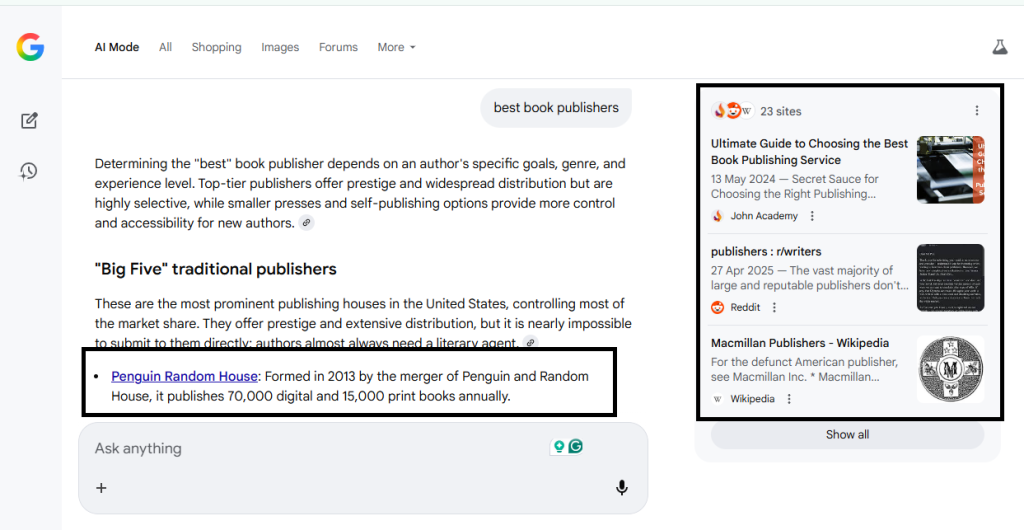
- SEO for publishers must shift focus from rankings to citations. Therefore, Publishers need to optimize for AI-driven snippets and conversational search queries. The articles should be designed in a Q&A format and focus on long-tail, question-based phrases.
- Publishers who understand what’s happening and adapt to new trends can stay ahead. They need to develop an essay to understand the content for AI. So that it can read clear headings, short summaries, and structured data. Moreover, they should focus on unique insights, expert analysis, and original reports that AI cannot easily replicate. And also, publishing companies should build direct relationships through newsletters and communities rather than depend solely on search traffic.
Frequently Asked Questions about SEO for Publishers
Publishers typically see initial SEO results within 3-6 months of consistent implementation. So you can build topical authority, and substantial organic traffic growth requires 6-12 months of strategic content optimization and publishing efforts.
Publisher SEO focuses on managing large content volumes, balancing news freshness with evergreen content, optimizing for Google News and Discover, handling duplicate content issues, and maintaining crawl efficiency across thousands of articles.
Publishers should follow the 70-30 rule: 70% evergreen content for sustained traffic and 30% timely news. Update breaking stories regularly, then repurpose them into comprehensive evergreen guides for long-term ranking potential.
Our Last Words Before We Conclude
So, we are at the end of our discussion of SEO for publishers. And I can assume you got all your queries covered. Yes, you can do Publisher SEO on your own for your publishing company, but if you take any professional SEO services for your publishing company, then you can do it more perfectly. Their SEO expert will plan your SEO strategy and execute it successfully. It will save you time and give you the optimal results for your publishing company.
So, take the next step forward into the SEO world and be a witness to something revolutionary for your publishing brand.

